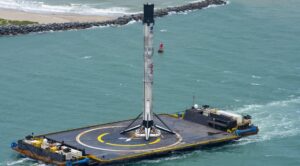NASA to allow reuse of Crew Dragon spacecraft and boosters
By Jeff Foust

WASHINGTON — NASA will allow SpaceX to reuse Crew Dragon spacecraft and the Falcon 9 first stages for launching them as soon as next year.
A modification to the Commercial Crew Transportation Capability (CCtCap) contract NASA has with SpaceX, published last month, will allow SpaceX to reuse both the Falcon 9 first stage and Crew Dragon spacecraft starting with the second operational mission of the spacecraft, known as Post-Certification Mission (PCM) 2 or Crew-2. That change was described as part of a “bilateral modification” that also formally extended the length of the Demo-2 mission from two weeks to as long as 119 days.
The move is a change for SpaceX, as the company originally planned to use a new Crew Dragon spacecraft on each of its commercial crew missions for NASA. That stood in contrast to Boeing, which will refurbish its CST-100 Starliner crew modules between flights.
Company officials earlier this year, though, hinted that they were now considering reusing Crew Dragon vehicles on NASA flights. “We intend for Crew Dragon to also be fully reusable,” said Benji Reed, director of crew mission management at SpaceX, during a briefing about a month before the launch of the Demo-2 mission. The Crew Dragon flying the Demo-2 mission, he said, would be reused, but didn’t say at the time if the spacecraft would be reused on a NASA or non-NASA mission.
NASA spokesperson Stephanie Schierholz said in response to SpaceNews questions about the contract modification that SpaceX approached NASA about allowing the reuse of spacecraft and boosters on later missions.
“In this case, SpaceX has proposed to reuse future Falcon 9 and/or Crew Dragon systems or components for NASA missions to the International Space Station because they believe it will be beneficial from a safety and/or cost standpoint,” she said. “NASA performed an in-depth review and determined that the terms of the overall contract modification were in the best interests of the government.”
The Demo-2 mission used both a new Crew Dragon spacecraft and new Falcon 9 rocket. The same will be true for the first operational mission, Crew-1 or PCM-1, scheduled for no earlier than Aug. 30. PCM-2 would launch some time in 2021, Schierholz said.
The reuse of a Falcon 9 booster or Crew Dragon spacecraft on any NASA mission will require a “delta-certification” review by NASA, she said, and NASA won’t allow any vehicles that are “flight leaders” in terms of service life be used for those missions. SpaceX has tended to test the limits of Falcon 9 booster reuse on its own Starlink launches, including a June 3 launch that marked the fifth launch and landing of the same booster.
SpaceX and NASA took a gradual approach to the reuse of the original cargo version of the Dragon spacecraft for missions under the company’s Commercial Resupply Services (CRS) contract with NASA. SpaceX won approval to start reusing Dragon spacecraft with the CRS-11 mission in 2017. Eight of the subsequent nine flights used previously flown capsules, with three capsules ultimately making three flights each.
SpaceX started reusing Falcon 9 boosters on CRS missions with CRS-13 in December 2017, which was the fourth Falcon 9 launch overall to use a reflown booster. Four of the seven CRS missions that followed also used boosters making their second flight.
SpaceX previously stated it planned to reuse the version of Crew Dragon that it will use for missions under its new CRS contract, starting later this year. That vehicle is similar to Crew Dragon but lacks some internal systems needed for crewed flights, as well as the SuperDraco thrusters for Crew Dragon’s launch abort system. The company estimates each cargo spacecraft should be able to make five flights.
“The number of flights right now is a design number. A lot of that depends on what you see when you come back,” said Hans Koenigsmann, vice president of build and flight reliability at SpaceX, at a NASA briefing before the launch of the final original cargo Dragon in March. “In reality, we might be able to run the capsule six times, or four times, depending on what we find.”
June 17, 2020 at 05:41AM
via SpaceNews.com read more...

Post a Comment